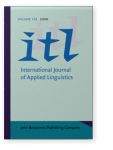Vol. 155 (2008) ► pp.77–93
Collex-Biz
A Corpus-Based Lexical Syllabus for Business English
This paper reports on the development of Collex-Biz, a corpus-driven web-based learning platform for general economic English. The design of this platform was informed by a number of research-based principles, particularly frequency and collocation, which are insufficiently incorporated in existing Business English course materials. Following Sinclair & Renouf (1988) and Nelson (2000), we first developed a ‘lexical syllabus’ for first-year Business English students on the basis of frequency data from a self-compiled 6 million word corpus of business news reports. A didactically inspired selection of the most useful single words and collocations was then thematically classified. On the basis of concordances, finally, exercises were created in which lexical items were maximally contextualised and systematically recycled. In this article, we discuss the criteria that guided our selection of items and elaborate on the principles behind the exercise design.
